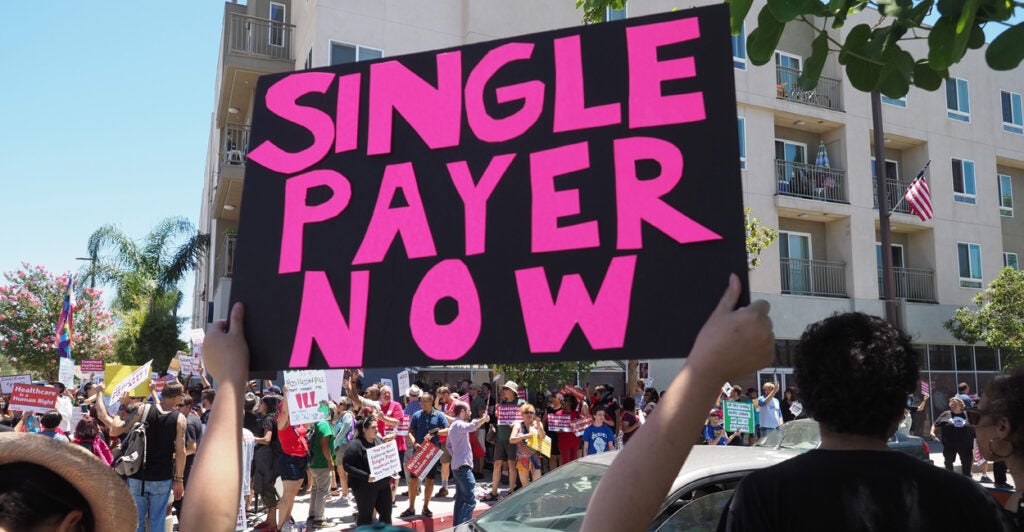The left never quits.
California’s “progressive” politicians are once again sponsoring a bill to create “CalCare,” a “single payer” system of state government-run health insurance. While California lawmakers plan to get federal waivers to integrate federal funding for Medicare and other federal programs into the new system, their bill would eliminate virtually all existing private and employer-sponsored health coverage.
Imagine the massive disruption. Of 39.5 million California residents, there are 2.7 million uninsured, and of that number, 1.2 million are eligible for financial assistance under the Affordable Care Act or Medicaid. This is not about coverage, it is about control.
Under the bill, the California government would provide a comprehensive health benefits package, ranging from prescription drugs and medical devices to mental health and nursing home care coverage.
All residents of California—including illegal immigrants—would be eligible to enroll, and medical services would be “free” at the point of service, meaning no premiums, deductibles, or other cost sharing. Medical professionals’ payment would be regulated on a fee-for service basis, and there would be severe restrictions on the ability of doctors to treat patients outside of the state government system.
Single-payer advocates in California and elsewhere routinely promise that their single-payer prescription would guarantee high-quality care for all at lower cost. Nonsense.
A rich professional literature shows that such a program delivers delays and denials of care, notably specialty care. Canada, a model “single payer” country, has one of the worst waiting times for care among the world’s economically advanced countries.
Likewise, waiting lists in the “single payer” British National Health Service are scandalous. Before the onset of the COVID-19 pandemic in 2019, there were 4.4 million patients (about twice the population of New Mexico) on British hospital waiting lists. With the pandemic, British waiting lists soared to 5.6 million in 2021, and British Health Secretary Sajid Javid is warning that the number could reach yet a jaw-dropping 13 million. So much for “free care” for all.
California’s politicians will doubtless promise that this time they will do it right. Yeah, right.
Taking the national pulse on the topic, the Kaiser Family Foundation’s 2020 survey showed that public opposition to “single payer” jumps to 70% when Americans realize that its adoption could lead to “delays” in people getting “some” medical tests and treatments. Even in the bluest of the blue states, “progressive” politicians could have a tough sell.
Pending approval of a state constitutional amendment by the voters, the program would be funded by a new 2.3% excise tax on businesses with annual revenues of $2 million. Bill sponsors also wish to impose a new payroll tax of 1.25% for employers with 50 or more workers, an additional 1% payroll tax on workers with an annual income of $49,000, a 2.5% surtax on persons with an annual income of $2.5 million, and an additional personal income tax for persons earning $149,509 annually.
If enacted, these new business and personal income taxes would be imposed on California residents who already pay the highest personal state income taxes in the nation, ranging from 1% to 12.3%, plus California sales tax rates that range from 7.25% to 10.75%.
According to a California Nurses Association analyst, these tax provisions would generate between $160 and $170 billion annually. Note, however, that the 2019 version of the California “single payer” bill—a broadly similar proposal with no funding provisions—would have cost as much as $400 billion per year, doubling California’s entire state budget.
The bill sponsors insist that the new taxes on California residents will turn out to be less than what they pay to finance their existing health insurance arrangements. Nonetheless, there are grounds for skepticism.
Heritage Foundation analysts, for example, estimated that the federal “Medicare for All” legislation would require an additional tax of 21.1% on earnings, hitting almost two-thirds of all American households—households that would end up paying more than they do today for health care.
Conservatives should welcome the controversy. During the 2019 debate on a similar California proposal, most California voters said that they would support a “single payer,” but “only” if it did not raise their taxes. Recall, too, that when Americans realized that they would have to pay more in taxes to fund a national “single payer” program, the Kaiser Family Foundation found that 60% opposed it.
California is losing population. Heavy tax burdens combined with high housing costs, increasing income inequality and homelessness, wokey politicians, and rising welfare dependency are undermining the quality of life in one of the nation’s most beautiful states.
This metastasizing cluster of social and economic pathologies has been contributing to an outmigration of California residents, particularly among middle-class residents. With more people leaving than coming, America’s once “Golden State” is no longer the sunny upland of economic opportunity.
The good news: America is a federal republic—a nation of states—and the rest of America can learn from the California experience without living it.
As Lord James Bryce, an astute British observer of American government, observed 134 years ago, if lawmakers in a certain state adopt “foolish” legislation … the mischief may stop at the State frontier instead of spreading through and tainting the nation at large.”
Have an opinion about this article? To sound off, please email letters@DailySignal.com and we’ll consider publishing your edited remarks in our regular “We Hear You” feature. Remember to include the URL or headline of the article plus your name and town and/or state.
